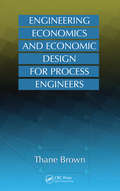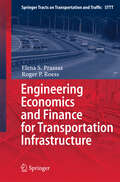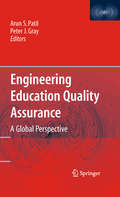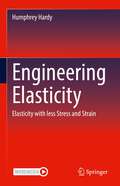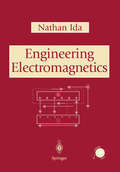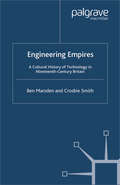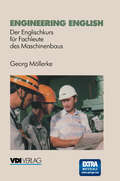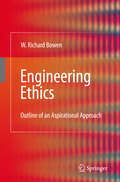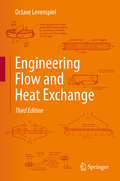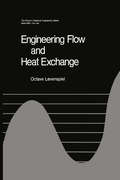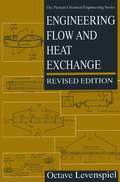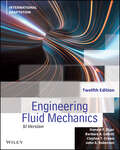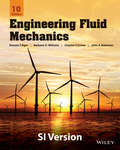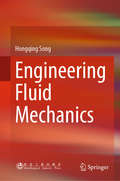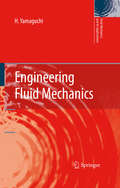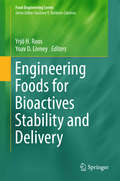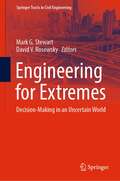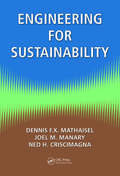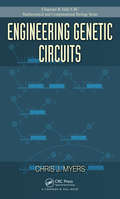- Table View
- List View
Engineering Economics and Economic Design for Process Engineers
by Thane BrownEngineers often find themselves tasked with the difficult challenge of developing a design that is both technically and economically feasible. A sharply focused, how-to book, Engineering Economics and Economic Design for Process Engineers provides the tools and methods to resolve design and economic issues. It helps you integrate technical a
Engineering Economics and Finance for Transportation Infrastructure (Springer Tracts on Transportation and Traffic #3)
by Elena S. Prassas Roger P. RoessThis textbook provides a fundamental overview of the application of engineering economic principles to transportation infrastructure investments. Basic theory is presented and illustrated with examples specific to the transportation field. It also reviews the history of transportation finance, as well as current methods for funding transportation investments in the U.S. Future problems and potential solutions are also discussed and illustrated.
Engineering Education Quality Assurance: A Global Perspective
by Arun Patil Peter GrayWith the rapid globalization of higher education as well as related changes in social, political, economic, and other conditions over the last 25 years there have been ever increasing expectations for higher education, in general, and Engineering Education, in particular. These expectations are often expressed in terms of the need for Quality Assurance locally, regionally, and globally. In some cases, there is a long tradition of independence and self-regulation of higher education institutions and programs. In other contexts, there has been c- siderable governmental regulation and disciplinary direction over time. The authors in this volume represent essentially all continents and 15 different countries. The common issues that they raise and their accounts of past, present, and future ch- lenges provide a snapshot of the current state of Quality Assurance in higher edu- tion and Engineering Education. This volume begins with an overview of the history and background of Quality Assurance in higher education and Engineering Education over the last century. The discussion of the historical, philosophical, political, and social background of Quality Assurance sets the stage for the other chapters. Following this broad brush stoke introduction, in the next part of the book, authors describe the general issues and challenges facing Quality Assurance in the twenty-first century from both regional and national perspectives. These authors have extensive experience in the area of Quality Assurance and have observed its growth and develop first hand over many years.
Engineering Elasticity: Elasticity with less Stress and Strain
by Humphrey HardyThis textbook aimed at upper-level undergraduate and graduate engineering students who need to describe the large deformation of elastic materials like soft plastics, rubber, and biological materials. The classical approaches to finite deformations of elastic materials describe a dozen or more measures of stress and strain. These classical approaches require an in-depth knowledge of tensor analysis and provide little instruction as to how to relate the derived equations to the materials to be described. This text, by contrast, introduces only one strain measure and one stress measure. No tensor analysis is required. The theory is applied by showing how to measure material properties and to perform computer simulations for both isotropic and anisotropic materials. The theory can be covered in one chapter for students familiar with Euler-Lagrange techniques, but is also introduced more slowly in several chapters for students not familiar with these techniques. The connection to linear elasticity is provided along with a comparison of this approach to classical elasticity.
Engineering Electromagnetics
by Nathan IdaThis text provides a good theoretical understanding of the electromagnetic field equations while also treating a large number of applications. In fact, no topic is presented unless it is directly applicable to engineering design or unless it is needed for the understanding of another topic. Electric motors and transformers are used to demonstrate the ideas of magnetic forces and torques and of induction; the applications discussed include the new super-efficient electric drives, linear induction motors, and implantable transformers to power life-sustaining devices. The discussion of wave-propagation phenomena includes applications of new materials to aerospace systems, such as the so-called stealth materials, as well as the use of electromagnetic weaves for materials processing, such as grain drying with microwaves, microwave detection of explosives, and remote sensing of the earth and its resources.
Engineering Empires: A Cultural History of Technology in Nineteenth-Century Britain
by B. Marsden C. SmithEngineers are empire-builders. Watt, Brunel, and others worked to build and expand personal and business empires of material technology and in so doing these engineers also became active agents of political and economic empire. This book provides a fascinating exploration of the cultural construction of the large-scale technologies of empire.
Engineering English: Der Englischkurs für Fachleute des Maschinenbaus (VDI-Buch)
by Georg MöllerkeDieser kurzweilige Englischkurs, der gute Schulkenntnisse voraussetzt, bringt Themen aus der Praxis des Maschineningenieurs, wie sie im beruflichen Alltag am häufigsten vorkommen. Die Grammatik ist auf das Nötigste beschränkt.
Engineering Ethics: Outline of an Aspirational Approach
by William Richard BowenAround the turn of the millennium, a young woman with outstanding academic achievements in science and mathematics applied to study engineering at a Eu- pean university. She had chosen to study engineering particularly because of the opportunities she expected it would give her to make a contribution to the well- ing of others. It happened that the university engineering department to which she applied had just been involved in the design of a vehicle for a world speed record attempt. When the young woman visited the university for interview this “triumph of technology” was presented as being a quintessential example of good engine- ing. However, though it was clear to her that the vehicle was technically ing- ious, she also recognised that it was of no practical use. She concluded that she had misunderstood the nature of engineering, and still wishing to help others she changed her plans and studied medicine, at which she assuredly excelled. This young woman’s change of career was undoubtedly a specific loss for en- neering. Additionally, it had a broader, tragic dimension; for her understanding of the purpose of engineering was more mature than that of the academics she - countered. Moreover, their imbalanced prioritisation of technical ingenuity over helping people is not uncommon within parts of the profession.
Engineering Flow and Heat Exchange (Chemical Engineering Ser.)
by Octave LevenspielThe third edition of Engineering Flow and Heat Exchange is the most practical textbook available on the design of heat transfer and equipment. This book is an excellent introduction to real-world applications for advanced undergraduates and an indispensable reference for professionals. The book includes comprehensive chapters on the different types and classifications of fluids, how to analyze fluids, and where a particular fluid fits into a broader picture. This book includes various a wide variety of problems and solutions – some whimsical and others directly from industrial applications.Numerous practical examples of heat transferDifferent from other introductory books on fluidsClearly written, simple to understand, written for students to absorb material quicklyDiscusses non-Newtonian as well as Newtonian fluidsCovers the entire field conciselySolutions manual with worked examples and solutions provided
Engineering Flow and Heat Exchange (The Plenum Chemical Engineering Series)
by Octave LevenspielThis volume presents an overview of fluid flow and heat exchange. In the broad sense, fluids are materials which are able to flow under the right conditions. These include all sorts of things: pipeline gases, coal slurries, toothpaste, gases in high-vacuum systems, metallic gold, soups and paints, and, of course, air and water. These materials are very different types of fluids, and so it is important to know the different classifications of fluids, how each is to be analyzed (and these methods are quite different), and where a particular fluid fits into this broad picture. This book treats fluids in this broad sense including flows in packed beds and fluidized beds. Naturally, in so small a volume, we do not go deeply into the study of any particular type of flow, however we do show how to make a start with each. We avoid supersonic flow and the complex subject of multiphase flow where each of the phases must be treated separately. The approach here differs from most introductory books on fluids which focus on the Newtonian fluid and treat it thoroughly, to the exclusion of all else. I feel that the student engineer or technologist preparing for the real world should be introduced to these other topics.
Engineering Flow and Heat Exchange (The Plenum Chemical Engineering Series)
by Octave LevenspielProfessor Levenspiel's text remains the most practical volume available on the design of heat transfer equipment - an excellent introduction to real-world applications for advanced undergraduates and an indispensable reference for professionals. Each chapter includes illustrative examples and problems.
Engineering Fluid Mechanics
by Donald F. Elger Barbara C. Williams Clayton T. Crowe John A. RobersonThe Tenth Edition of Crowe's Engineering Fluid Mechanics builds upon the strengths and success of the previous edition, including a focus on pedigogical support and deep integration with WileyPLUS, providing considering deeper support for development of conceptual understanding and problem solving. This new edition retains the hallmark features of Crowe's distinguished history: clarity of coverage, strong examples and practice problems, and comprehensiveness of material, but expands coverage to include Computational Fluid Dynamics.
Engineering Fluid Mechanics
by Hongqing SongThis book systematically introduces engineering fluid mechanics in a simple and understandable way, focusing on the basic concepts, principles and methods. Engineering fluid mechanics is necessary for professionals and students in fields such as civil, environmental, mechanical, and petroleum engineering. Unlike most of the current textbooks and monographs, which are too complicated and include huge numbers of math formulas and equations, this book introduces essential concepts and flow rules in a clear and elementary way that can be used in further research. In addition, it provides numerous useful tables and diagrams that can be quickly and directly checked for industry applications. Furthermore, it highlights the connection between free flow and porous flow, which can aid advanced interdisciplinary research such as nanotech and environmental science. Last but not least, each chapter presents a variety of problems to offer readers a better understanding about the principles and applications of fluid mechanics.
Engineering Fluid Mechanics (Fluid Mechanics and Its Applications #85)
by H. YamaguchiA real boon for those studying fluid mechanics at all levels, this work is intended to serve as a comprehensive textbook for scientists and engineers as well as advanced students in thermo-fluid courses. It provides an intensive monograph essential for understanding dynamics of ideal fluid, Newtonian fluid, non-Newtonian fluid and magnetic fluid. These distinct, yet intertwined subjects are addressed in an integrated manner, with numerous exercises and problems throughout.
Engineering Foods for Bioactives Stability and Delivery (Food Engineering Series)
by Yrjö H. Roos Yoav D. LivneyThis book introduces recovery and stabilization of common bioactive materials in foods as well as materials science aspects of engineering stable bioactive delivery systems. The book also describes most typical unit operations and processes used in recovery and manufacturing of food ingredients and foods with stabilized bioactive components. The 15 chapters of the book discuss in detail substances that need to be protected and delivered via foods and beverages to achieve good stability, bioavailability and efficacy. Dedicated chapters present current and novel technologies used for stabilization and delivery of bioactive components.The material included covers formulation, stability, digestive release, bioaccessability and bioavailability. The text features a special emphasis on the materials science and technological aspects required for stabilization and successful production of foods with bioactive components. Consumer demand for healthier, yet satisfying food products is posing increasingly tough challenges for the food industry. Scientific research reveals new bioactive food components and new functionalities of known components.Food materials science has also developed to a stage where food materials can be designed and produced to protect sensitive components for their delivery in complex food products. Such delivery systems must meet high safety and efficacy requirements and regulations, as well as economic viability criteria and consumer acceptance.
Engineering for Extremes: Decision-Making in an Uncertain World (Springer Tracts in Civil Engineering)
by Mark G. Stewart David V. RosowskyThe volume explains how risk and decision-making analytics can be applied to the wicked problem of protecting infrastructure and society from extreme events. There is increasing research that takes into account the risks associated with the timing and severity of extreme events in engineering to reduce the vulnerability or increase the resiliency of infrastructure. "Engineering for extremes" is defined as measures taken to reduce the vulnerability or increase the resiliency of built infrastructure to climate change, hurricanes, storms, floods, earthquakes, heat waves, fires, and malevolent and abnormal events that include terrorism, gas explosions, vehicle impact and vehicle overload. The book introduces the key concepts needed to assess the economic and social well-being risks, costs and benefits of infrastructure to extreme events. This includes hazard modelling (likelihood and severity), infrastructure vulnerability, resilience or exposure (likelihood and extent of damage), social and economic loss models, risk reduction from protective measures, and decision theory (cost-benefit and utility analyses). Case studies authored by experts from around the world describe the practical aspects of risk assessment when deciding on the most cost-efficient measures to reduce infrastructure vulnerability to extreme events for housing, buildings, bridges, roads, tunnels, pipelines, and electricity infrastructure in the developed and developing worlds.
Engineering for Sustainability: Engineering For Sustainability
by Dennis F.X. Mathaisel Joel M. Manary Ned H. CriscimagnaSustainability and sustainable development have become popular goals. They have also become wide-ranging terms that can be applied to any entity or enterprise on a local or a global scale for long time periods. As enterprises and systems become more complex and development a support costs increase, the question remains: how does one engineer an ent
Engineering Frontiers: A Multidisciplinary Odyssey (Advanced Structured Materials #208)
by Andreas Öchsner Azman Ismail Mohd Amran Mohd Daril Fatin Nur ZulkipliThis book describes a diverse collection of engineering research and innovations across 35 chapters. Each chapter unveils a facet of modern engineering excellence. This book not only presents cutting-edge solutions but also addresses environmental sustainability. This book is an illuminating expedition into the heart of innovation, showcasing the ingenuity and collaborative spirit that define the future of engineering.
Engineering Genetic Circuits (Chapman And Hall/crc Mathematical And Computational Biology Ser.)
by Chris J. MyersAn Introduction to Systems BioengineeringTakes a Clear and Systematic Engineering Approach to Systems BiologyFocusing on genetic regulatory networks, Engineering Genetic Circuits presents the modeling, analysis, and design methods for systems biology. It discusses how to examine experimental data to learn about mathematical models, develop efficien
Engineering Geology for a Habitable Earth: Volume 5: Megacity Development and Preservation of Cultural Heritage Engineering Geology (Environmental Science and Engineering)
by Rafig Azzam Runqiu Huang Vassilis P. Marinos Sijing WangThis book collects the selected papers of the XIV Congress of the International Association for Engineering Geology and the Environment held in Chengdu, Sichuan, China from September 21st - 27th, 2023, with the theme of Engineering Geology for a Habitable Earth. The meeting proceedings analyses the dynamic role of engineering geology in our changing world. The congress is expected to enhance the inter-disciplinary research development of international engineering geology and the environment, and contribute to the advancement of major projects, ecological progress, and habitable earth with in-depth discussion in the area of engineering geology and global climate change, geological hazard assessment and prevention, geotechnical properties of rock and soil mass, engineering geology and the environmental issues concerning marine, transportation, urban and ecological environment protection, engineering geology and resilience engineering construction, intelligent engineering geology, and new theories, methods, and techniques in engineering geology.
Engineering Geology for a Habitable Earth: Volume 3: Active Tectonics, Geomorphology, Climate and Geoenvironmental Engineering Geology (Environmental Science and Engineering)
by Rafig Azzam Runqiu Huang Vassilis P. Marinos Sijing WangThis book collects the selected papers of the XIV Congress of the International Association for Engineering Geology and the Environment held in Chengdu, Sichuan, China from September 21st - 27th, 2023, with the theme of Engineering Geology for a Habitable Earth. The meeting proceedings analyses the dynamic role of engineering geology in our changing world. The congress is expected to enhance the inter-disciplinary research development of international engineering geology and the environment, and contribute to the advancement of major projects, ecological progress, and habitable earth with in-depth discussion in the area of engineering geology and global climate change, geological hazard assessment and prevention, geotechnical properties of rock and soil mass, engineering geology and the environmental issues concerning marine, transportation, urban and ecological environment protection, engineering geology and resilience engineering construction, intelligent engineering geology, and new theories, methods, and techniques in engineering geology.
Engineering Geology for a Habitable Earth: Volume 4: Technological Innovation and Application for Engineering Geology (Environmental Science and Engineering)
by Rafig Azzam Runqiu Huang Vassilis P. Marinos Sijing WangThis book collects the selected papers of the XIV Congress of the International Association for Engineering Geology and the Environment held in Chengdu, Sichuan, China from September 21st - 27th, 2023, with the theme of Engineering Geology for a Habitable Earth. The meeting proceedings analyses the dynamic role of engineering geology in our changing world. The congress is expected to enhance the inter-disciplinary research development of international engineering geology and the environment, and contribute to the advancement of major projects, ecological progress, and habitable earth with in-depth discussion in the area of engineering geology and global climate change, geological hazard assessment and prevention, geotechnical properties of rock and soil mass, engineering geology and the environmental issues concerning marine, transportation, urban and ecological environment protection, engineering geology and resilience engineering construction, intelligent engineering geology, and new theories, methods, and techniques in engineering geology.
Engineering Geology for a Habitable Earth: Volume 2: Geohazard Mechanisms, Risk Assessment and Control, Monitoring and Early Warning (Environmental Science and Engineering)
by Rafig Azzam Runqiu Huang Vassilis P. Marinos Sijing WangThis book collects the selected papers of the XIV Congress of the International Association for Engineering Geology and the Environment held in Chengdu, Sichuan, China from September 21st - 27th, 2023, with the theme of Engineering Geology for a Habitable Earth. The meeting proceedings analyses the dynamic role of engineering geology in our changing world. The congress is expected to enhance the inter-disciplinary research development of international engineering geology and the environment, and contribute to the advancement of major projects, ecological progress, and habitable earth with in-depth discussion in the area of engineering geology and global climate change, geological hazard assessment and prevention, geotechnical properties of rock and soil mass, engineering geology and the environmental issues concerning marine, transportation, urban and ecological environment protection, engineering geology and resilience engineering construction, intelligent engineering geology, and new theories, methods, and techniques in engineering geology.
Engineering Geology for a Habitable Earth: Volume 1: Engineering Geomechanics of Rock and Soil Masses (Environmental Science and Engineering)
by Rafig Azzam Runqiu Huang Vassilis P. Marinos Sijing WangThis book collects the selected papers of the XIV Congress of the International Association for Engineering Geology and the Environment held in Chengdu, Sichuan, China from September 21st - 27th, 2023, with the theme of Engineering Geology for a Habitable Earth. The meeting proceedings analyses the dynamic role of engineering geology in our changing world. The congress is expected to enhance the inter-disciplinary research development of international engineering geology and the environment, and contribute to the advancement of major projects, ecological progress, and habitable earth with in-depth discussion in the area of engineering geology and global climate change, geological hazard assessment and prevention, geotechnical properties of rock and soil mass, engineering geology and the environmental issues concerning marine, transportation, urban and ecological environment protection, engineering geology and resilience engineering construction, intelligent engineering geology, and new theories, methods, and techniques in engineering geology.
